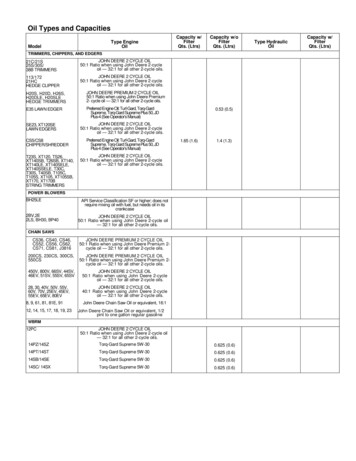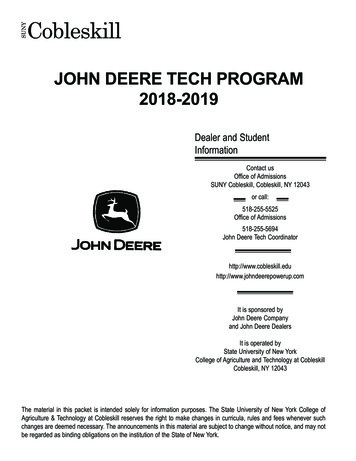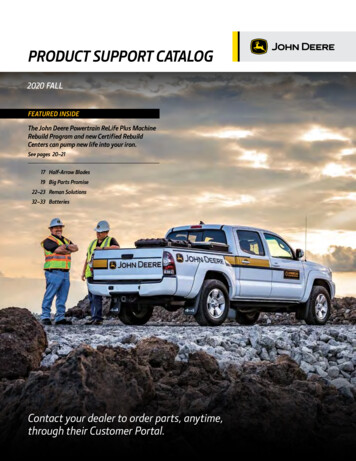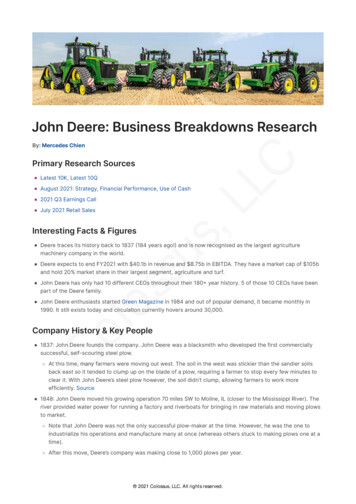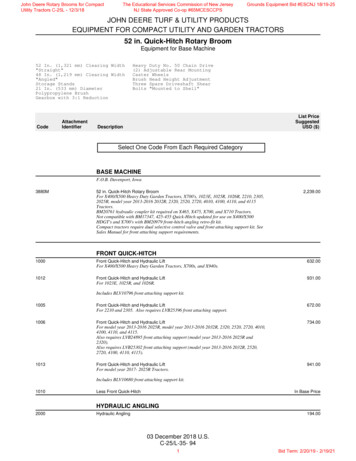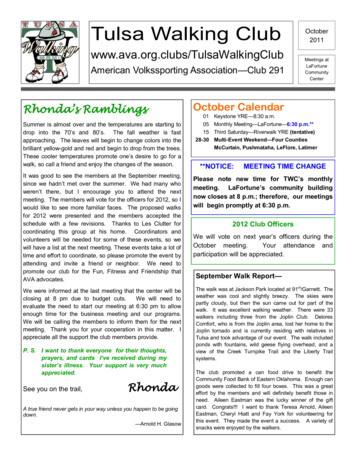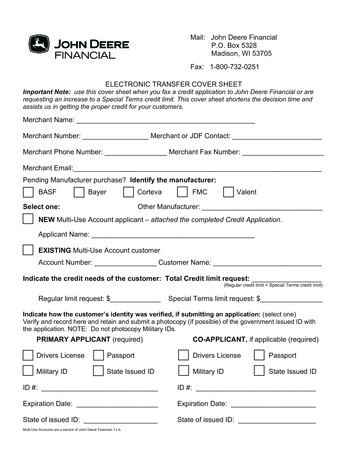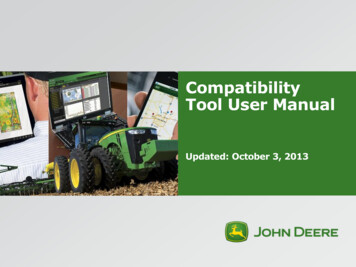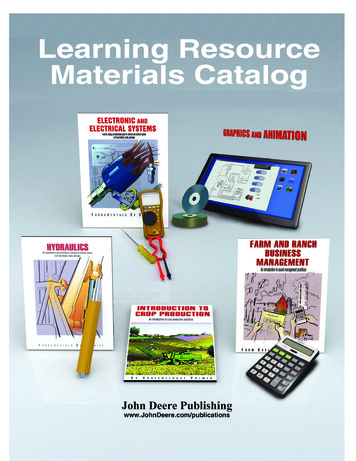
Transcription
ContentsSERIES INFORMATIONSeries Information.3How To Order.4Returned Goods Policy.4Discounts/Prices.4Payment for Orders.4PRIMER SERIESIntroduction to Crop Production.5The Precision Farming Guide for Agriculturists - Revised!.5FARM BUSINESS MANAGEMENT SERIESFarm and Ranch Business Management.6Farm and Ranch Safety Management.7Machinery Management.8FUNDAMENTALS OF SERVICE SERIESAir Conditioning.9Bearings and Seals.9Belts and Chains.10Electronic and Electrical Systems.11Engines.12Fasteners.13Fuels, Lubricants, Coolants, and Filters.13Glossary of Technical Terms.14Hoses, Tubing, and Connectors.14Hydraulics.15Hydraulic Systems Diagnostics.16Identification of Parts Failures.17Power Trains.18Shop Tools.19Tires and Tracks.19Welding.20FUNDAMENTALS OF MACHINE OPERATION SERIESCombine Harvesting.21Hay and Forage Harvesting.22Preventive Maintenance.23Tillage.24Tractors.24COMPACT EQUIPMENT SERIESEngines (Up to 40-PTO Horsepower).25Safety Management for Landscapers, Grounds-Care Businesses, and Golf Courses.26
Series Information1) Agricultural Primer Series: Covers the fundamentals ofan agricultural subject using simple, direct language to breakcomplex concepts into simple ideas. The book deals withsubjects that change rapidly and contain technology that isconstantly evolving.2) Farm Business Management Series: Examines the key tosurvival of the farm and ranch: good business management.These books examine “real world” problems and offer practicalsolutions. They furnish information enabling the student to makethe best decision — in marketing; equipment selection; riskmanagement; cost reduction; financing; and tillage, planting, andharvesting methods.John Deere Publishing has been delivering curriculum since1968 and has printed over a million manuals over the years.Our books are intended with the primary audience being our ownemployees; however, we design them with the technical studentin mind.Our titles range from farm business management to machineryoperation and service. Each subject is explained in a step-by-step“building block” method that starts with simple concepts andbuilds into complex systems. Important points are illustrated tohelp students quickly grasp the principles. Most major designsand systems are covered, but no brands or models are mentioned.You can use our books even if another manufacturer has donatedits equipment to your school.Our textbooks will help students to think and analyze, enablingthem to become better technicians or machine operators of largeor small equipment. Our Student Guides will help your studentsdevelop their understanding more easily, and our InstructorGuides and Art Catalogs will help instructors prepare for classand laboratory activities with clear learning objectives andteaching strategies.3) Fundamentals of Service Series: These books concentrate onmechanical technology, bringing together technical informationand supporting instructional aids that will help you becomemore proficient in understanding, repairing, and maintainingagricultural equipment. Many external companies (such asFederal Express, California Department of Transportation, HertzEquipment Rental, Proctor & Gamble, Ingersol-Rand, etc.) usethis series to conduct their in-house service training.4) Fundamentals of Machine Operation Series: Showsmuch more than how to safely operate equipment. Studentslearn machine capacities and adjustments, field efficiency,how to improve machine performance, and how to eliminateunnecessary field operation.5) Fundamentals of Compact Equipment Service Series:Provides comprehensive instruction in servicing and maintainingequipment having up to 40-PTO horsepower, including lawnmowers, garden machinery, and snowblowers.3SERIES INFORMATIONSubjects are broken down into five series:
How To OrderSERIES INFORMATIONVisit the John Deere Technical Information Store atJohnDeere.com/TechInfoStore to purchase orders via CreditCard.All orders can be placed through our Customer ServiceDepartment. They are available between 7:30 a.m. and 4:00 p.m.Central Standard Time, Monday through Friday. Please contactJohn Deere Publications at 1-800-522-7448.To receive tax exempt status or discounts, orders must be placedby calling John Deere Publications at 1-800-522-7448. There areno tax exemptions when ordering online.Returned Goods PolicyReturns will not be allowed unless the product shipped is due toan error by John Deere Technical Information Store. Manualsmust be returned within 30 days from the date of shipmentfor replacement only. Shipment errors can be corrected bycontacting us at Deere Bookstore Support.No returns on electronic products, such as CD/DVD products,will be allowed, except for defective CD/DVD electronicproducts, which may be returned for replacement only. Requestsfor substitution cannot be honored.Discounts/PricesPrices are subject to change at any time. Receive a 10% discount on any combination of titles when10 or more items are ordered. Receive a 25% discount if the entire catalog of manuals isordered in a set. Wholesaler/distributor discounts are also available.Payment for OrdersWe accept credit cards, including VISA, MasterCard, Discover,American Express, John Deere Credit Card, and Farm PlanPreferred Accounts.www.JohnDeere.com/Publications4
Introduction to Crop ProductionPRIMER SERIESIntroduction to Crop Production is a brief overview of the processes, principles, and practicesassociated with crop production.Some of the questions that this book addresses include: What are the basic needs of a growing crop, and how does the farmer accommodate them? What tools does the farmer employ to productively plant, nourish, protect, and harvest acrop? What drives the choices and decisions involved in managing crop production activities?A complete glossary of terms used within this book, related to crop production, is also included.InstructorArt Catalog CDTextbook1st Edition, 2010Crop Production Yesterday and TodayChapter 2.Soil 6691-364-5Chapter 3.Chapter 4.PlantingFP701NCFP701TDChapter 5.Chemical Application Management168N/AChapter 6.Combine Harvesting 43.95 17.95Chapter 7.Hay and Forage HarvestingChapter 8.Precision FarmingChapter 9.Machinery ManagementChapter 10.Glossary of TermsISBN: 978-0-86691-363-8Order No.:Page Count:Price:Chapter 1.The Precision Farming Guide for AgriculturistsRevisedThe Precision Farming Guide for Agriculturists is an overview of site-specific farming andits many varied systems and applications. This book discusses the following in detail: typesof positioning systems, from land-based to global positioning systems to geostationarysatellite systems; yield monitoring systems; mapping, soil sampling, and soil testing; and newtechnologies, such as remote sensing, variable rate technology, and geographic informationsystems.The Precision Farming Guide for Agriculturists also closely studies important considerations thatevery agriculturist needs to examine, beginning with whether site-specific farming is for you. Itthen explores system development and integration, economic considerations, and environmentalconsiderations.A complete glossary of precision-farming terms is included, along with an extensive suggestedreadings list (books, journals, magazine articles, and websites).Chapter 1.An Introduction to Precision FarmingChapter 2.Satellite Based Positioning SystemsChapter 3.Yield Monitoring and MappingChapter 4.Soil Sampling and AnalysisChapter 5.Remote SensingChapter 6.Computers and Geographic Information SystemsChapter 7.Variable Rate TechnologiesChapter 8.Precision Farming — Issues toConsiderInstructorGuide 4th Edition,InstructorArt Catalog 91-434-XFP404NCFP404TFP404TDTextbook4th Edition, 2017ISBN:Order No.:Page Count:Price: 201716864212 43.95 28.95 17.955
Farm and Ranch Business ManagementFARM BUSINESS MANAGEMENT SERIESDeveloped with the cooperation of the National FFA Farm Business Management ContestCommittee, this book remains the definitive text on managing a farm or ranch on sound businessprinciples.An important key to the survival of the farm and ranch is good business management. The newbreed of farmers and ranchers that are emerging must know how to apply management principlesto their operation in order to make the most profit. They must be able to compete and win ina highly volatile worldwide commodity marketplace. Being able to do so requires extensiveknowledge of all aspects of the business.Until the first edition of this book, a serious gap existed in the quest for this knowledge. Inresponse, Deere & Company developed Farm and Ranch Business Management. This was, andis, a basic book that is the first word on the subject. It was written by the experts as a practicalguide for the agribusiness manager. It explains in plain English the principles and techniques thatevery farmer and rancher must know.IntroductionChapter 2.Record KeepingChapter 3.Financial AnalysisChapter 4.Budget AnalysisChapter 5.Cost And Return AnalysisChapter 6.MarketingChapter 7.Investment AnalysisChapter 8.TaxesChapter 9.Business OrganizationsChapter 10.Ag LawChapter 11.Risk ManagementChapter 12.International Trade6Chapter 1.Textbook8th Edition, 2017ISBN:Order No.:Page Count:Price:InstructorGuide8th Edition, 2017StudentGuide8th Edition, 2017Instructor ArtCatalog CD8th Edition, -440-4978-0-86691-437-6 978-0-86691-438-3 978-0-86691-439-0 108TD234124132N/A 50.95 42.95 29.95 17.95
Farm and Ranch Safety ManagementFARM BUSINESS MANAGEMENT SERIESYou can’t afford even one accident! Careful planning can help avoid tragic — and costly —accidents. Why do you need this book? The answer is simple: agriculture is a hazardous industry.Farming and ranching can be uniquely rewarding occupations, but if you don’t follow safe workpractices they can be dangerous. According to the National Safety Council (NSC), there werean estimated 1,200 agricultural work-related deaths and 140,000 disabling work-related injuriesin the United States in 1992. But you already knew farming and ranching are filled with danger.What you may not know so well is what you can do about it. This book will tell you. We will telland show you 21 ways to avoid the No. 1 fatal farm accident — and that’s just for starters. Weshow you very practical ways to avoid pinch points; wrapping, shearing, crushing, and pull-inhazards; thrown objects and freewheeling parts; electrical and stored energy; and much, muchmore.Farm and Ranch Safety Management is the definitive reference work in rural safety. This 394page book is filled with EPA, OSHA, and other regulatory agency standards, and suggested waysto meet or exceed those standards. Topics covered in simple, straightforward language includesafe machine operation, handling toxic chemicals, hazardous waste disposal, and developing anoverall safety management plan.ISBN:Order No.:Page Count:Price:TextbookChapter 1.Safe Farm Machinery Operation5th Edition, 2009Chapter 2.Human Factors and Ergonomics0-86691-352-1978-0-86691-352-2Chapter 3.Recognizing Common Machine HazardsChapter 4.Managing Farm/Ranch SafetyFBM18105NCChapter 5.Equipment Service and MaintenanceChapter 6.Waste Recycling and DisposalChapter 7.Tractors and ImplementsChapter 8.Tillage and Planting EquipmentChapter 9.Chemical SafetyChapter 10.Hay and Forage EquipmentChapter 11.Grain and Cotton Harvesting EquipmentChapter 12.Material Handling EquipmentChapter 13.Farm Maintenance Equipment394 59.957
Machinery ManagementFARM BUSINESS MANAGEMENT SERIESThe ability to manage machinery is an important skill that must be mastered by farmers andranchers who want to compete in our complex worldwide commodity marketplace. With thebasic information in this book, you can build a solid foundation of knowledge that can beused to make the most efficient machinery management decisions and help keep your businesscompetitive.There is no substitute for personally solving a machinery management problem. You should notrely on the “short cut” methods of others when you make decisions that affect your business.The data and formulas in this text are based on the latest information available to improve theaccuracy of your machinery management decisions.The book is divided into three sections. The first section covers how to become more efficient bymatching machines and power units to different situations. The second section gives informationthat can be used to estimate and analyze costs so better machinery management choices can bemade. The final section gives several examples of the application of information contained in thefirst two sections to illustrate the value of making decisions on a sound, economical basis.Throughout this book, emphasis is placed on solving practical problems with either a computeror hand calculator. Whether you use a computer or a hand calculator, you will be pleasantlysurprised at the wide variety of management decisions that you can make once you master theseexample problems.Matching Machines and Power UnitsChapter 1.IntroductionChapter 2.Measuring Machine CapacityChapter 3.Improving Field EfficiencyChapter 4.Matching Machine Size and CapacityChapter 5.Estimating Power RequirementsChapter 6.Estimating Fixed CostsChapter 7.Estimating Fuel and Lubricant CostsChapter 8.Estimating Repair CostsChapter 9.Total Costs for Machines and OperationsChapter 10.Deciding When to TradeChapter 11.Considering Future Capacity NeedsChapter 12.Calculating Custom Work CostsChapter 13.Decision Time—Selecting the Best AlternativeChapter 14.Case Studies in Machinery ManagementEstimating Machinery CostsManaging Machinery8Textbook6th Edition, 2008ISBN:Order No.:Page NC202 43.95
Air ConditioningFUNDAMENTALS OF SERVICE SERIESAir Conditioning is the definitive “how-to” book on air conditioning systems of off-roadvehicles, trucks, buses, and automobiles — from showing you how to diagnose problems andtest components to explaining how to repair the system. And when we say “show you,” wemean just that! Our book is filled with illustrations to clearly demonstrate what must be done —photographs, drawings, pictorial diagrams, troubleshooting charts, and diagnostic charts.Instructions are written in simple language so that they can be easily understood. Starting withhow air conditioning works, we build up to why it fails and what to do about it. This book can beused by anyone, from a novice to an experienced mechanic.By starting with the basics, the book builds your knowledge step by step. Chapter 1 providesimportant safety information. Chapter 2 covers the basic principles of refrigeration. Chapter 3covers the use of refrigerants, including how to properly recycle and dispose of them. In Chapter4, the basic systems are introduced. The rest of the book covers testing, diagnosing, inspecting,and servicing complete systems.Air Conditioning explains some of the EPA and OSHA regulations pertaining to evacuatingsystems and refrigerant recovery.Textbook11th Edition, 2014ISBN:Order No.:Page Count:Price:InstructorArt Catalog CD0-86691-407-20-86691-411-0978-0-86691-407-9 978-0-86691-411-6FOS5711NCFOS5711TD134N/A 36.95 17.95Chapter 1.SafetyChapter 2.Basics of Air ConditioningChapter 3.Refrigerants and OilChapter 4.Basic System: How It WorksChapter 5.Service EquipmentChapter 6.Inspecting the SystemChapter 7.Diagnosing the SystemChapter 8.Testing and Adjusting the SystemChapter 9.Preparing System for ServiceBearings and SealsBearings and Seals is the definitive “how-to” book when it comes to this subject — fromshowing you how to diagnose problems and test for failed parts to explaining how to repair thesystem. And when we say “show you,” we mean just that! Our book is filled with illustrationsto clearly demonstrate what must be done — photographs, drawings, pictorial diagrams,troubleshooting charts, and diagnostic charts.Instructions are written in simple language so that they can be easily understood. Startingwith the question “how does it work?” the book builds up to “why does it fail?” and finisheswith “what to do about it.” This book can be used by anyone, from a novice to an experiencedmechanic.Bearings and Seals can easily help the reader to better understand bearings and seals. By startingwith the basics, it builds your knowledge step by step in a very structured manner.Chapter 1.BearingsChapter 2.SealsChapter 3.SafetyTextbook8th Edition, 2014ISBN:Order No.:Page Count:Price:Instructor ArtCatalog CD0-86691-408-00-86691-412-9978-0-86691-408-6 978-0-86691-412-3FOS5407NCFOS5407TD138N/A 36.95 17.959
Belts and ChainsFUNDAMENTALS OF SERVICE SERIESBelts and Chains is a basic guide to the maintenance, installation, and failure of belt and chaindrives.Belts and Chains is the definitive “how-to” book on the drive systems of off-road vehicles,trucks, buses, and automobiles — from showing you how to inspect them and diagnose problemsto giving you step-by-step repair procedures and explaining in detail how to maintain them toavoid future problems. And when we say “show you,” we mean just that! Our book is filledwith illustrations to clearly demonstrate what must be done — photographs, drawings, pictorialdiagrams, troubleshooting charts, and diagnostic charts.Instructions are written in simple language so that they can be easily understood. Startingwith the question “how does it work?” the book builds up to “why does it fail?” and finisheswith “what to do about it.” This book can be used by anyone, from a novice to an experiencedmechanic.Belts and Chains can easily help a reader to better understand the workings of belt and chaindrive components. By starting with the basics, it builds your knowledge step by step in a verystructured manner.Chapter 1.BeltsChapter 2.ChainsTextbook7th Edition, 2012ISBN:Order No.:Page 7NC88 22.95
Electronic and Electrical SystemsFUNDAMENTALS OF SERVICE SERIESElectronic and Electrical Systems is the definitive “how-to” book on the electrical systems ofoff-road vehicles, trucks, buses, and automobiles — from showing you how to diagnose problemsand test components to explaining how to repair the system. And when we say “show you,” wemean just that! Our book is filled with illustrations to clearly demonstrate what must be done —photographs, drawings, pictorial diagrams, troubleshooting charts, and diagnostic charts. We evenexplain how to read and understand electrical wiring diagrams and diagnostic charts! How’s thatfor being helpful?Instructions are written in simple language so that they can be easily understood. This book canbe used by anyone, from a novice to an experienced mechanic.By starting with the basics, the book builds your knowledge step by step. Chapter 1 details thedangers of electricity and describes how to safely work with electrical systems. Chapter 2 coversthe principles of electricity and explores the electron and how to measure it. Chapters 3–13go into detail about electrical systems and provide information for properly maintaining anddiagnosing circuits. Chapter 14 gives a basic introduction to mathematics for electronics andcontrollers. Chapters 15 and 16 cover basic components found within a controller and the sensorsthat controllers rely on for information. Chapter 17 covers the basic operation of computers andprogrammable controllers. Chapter 18 gives an explanation of today’s off-road hybrid systems.Textbook10th Edition, 2014ISBN:Order No.:Page Count:Price:InstructorGuide10th Edition, 2014StudentGuide10th Edition, 2014InstructorArt Catalog 13-7978-0-86691-409-3 978-0-86691-418-5 978-0-86691-419-2 D630208246N/A 52.95 44.95 33.95 17.95Chapter 1.Electrical SafetyChapter 2.Electricity—How It WorksChapter 3.Electrical ComponentsChapter 4.ElectromechanicalComponentsChapter 5.Storage BatteriesChapter 6.Charging CircuitsChapter 7.Starting CircuitsChapter 8.Ignition CircuitsChapter 9.Electronic Ignition and FuelInjection SystemsChapter 10.Lighting and AccessoryCircuitsChapter 11.ConnectorsChapter 12.General MaintenanceChapter 13.Diagnosis and Testing ofSystemsChapter 14.Introduction to Mathematicsfor ControllersChapter 15.Electronic ComponentsChapter 16.SensorsChapter 17.Controllers and MonitorsChapter 18.Hybrid Systems11
EnginesFUNDAMENTALS OF SERVICE SERIESEngines is the definitive “how-to” book on the engines of off-road vehicles, trucks, and buses —from showing you how to diagnose problems and test components to explaining how to repairthe system. And when we say “show you,” we mean just that! Our book is filled with illustrationsto clearly demonstrate what must be done — photographs, drawings, pictorial diagrams,troubleshooting charts, and diagnostic charts.Instructions are written in simple language so that they can be easily understood. This book canbe used by anyone, from a novice to an experienced mechanic. And it can be used to work onmany different kinds of engines, from gasoline to LP-gas to diesel.By starting with the basics, the book builds your knowledge step by step. This book covershow engines work; gives basic engine information, from cylinder heads through clutches; andexamines the different kinds of fuel systems, to include the latest electronically controlled fuelsystems. It also goes into detail about the different kinds of corollary systems (intake, exhaust,lubrication, cooling, and governing) and their working parts; information on test equipment andservice tools; plus a complete diagnosis and testing chapter. This book includes information onelectronic sensors and how they are used to control and monitor engine operation. It also includesinformation on how to do a tune-up.Chapter 1.How Engines WorkChapter 2.Safety Rules forEnginesChapter 3.Basic EngineChapter 4.Gasoline Fuel SystemsChapter 5.LP-Gas Fuel SystemsChapter 6.Natural Gas FuelSystemsChapter 7.Diesel Fuel SystemsChapter 8.Intake and ExhaustSystemsChapter 9.Lubrication SystemsChapter 10.Cooling SystemsChapter 11.Governing SystemsChapter 12.Engine Test Equipmentand Service ToolsChapter 13.Diagnosis and TestingChapter 14.Engine Tune-Up12Textbook12th Edition, 2015ISBN:Order No.:Page rt Catalog CD12th Edition, 201512th Edition, S3012TD51011496N/A 52.95 44.95 31.95 17.95
FastenersFUNDAMENTALS OF SERVICE SERIESThis book is, as you might have guessed, about fasteners, those simple devices that are used everyday in the home or workshop to fasten things together. Fasteners explores bolts, screws, nuts,pins, washers, keys, studs, snap rings, rivets, adhesives, and many, many others.A lot has been written about fasteners, but it is scattered in many publications and is often writtenin technical engineering terms. One purpose of this book is to consolidate, in one publication, allthe basic information on fasteners, written simply so it will be easily understood.We’ve attempted to limit the information to those features of fasteners that will be of most interestand use to our readers — a description of each fastener, its purpose, its special uses, and how it isdesignated and measured.Fasteners also includes instructions for removing and installing certain fasteners, if specialtechniques are necessary. The meaning of special fastener terms and symbols, often technical andnot always understood, are also explained.Because the proper tightening of many bolts, nuts, and cap screws has become critical in modernmachines, we have included an entire chapter to discuss tension and torque.TextbookISBN:Order No.:Page Count:Price:Chapter 1.Importance of Fasteners6th Edition, 2008Chapter 2.Bolts, Cap Screws, Nuts, Washers, and Locking Devices0-86691-349-1978-0-86691-349-2Chapter 3.Working with Bolts, Cap Screws, and NutsChapter 4.Screws, Keys, Studs, Snap Rings, Rivets and ClampsChapter 5.Specialty and Plastic FastenersChapter 6.Adhesives and SealantsChapter 7.Tables, Torques, and MetricsFOS6006NC100 24.95Fuels, Lubricants, Coolants, and FiltersFuels, Lubricants, Coolants and Filters is the definitive “how-to” book when it comes to thissubject — from showing you the different types of each; to their characteristics, designations, andadditives; to diagnosing system problems and identifying parts failure; to explaining how to repairthe systems. And when we say “show you,” we mean just that! Our book is filled with illustrationsto clearly demonstrate what must be done — photographs, drawings, pictorial diagrams,troubleshooting charts, and diagnostic charts.Instructions are written in simple language so that they can be easily understood. Starting with thequestion “how does it work?” the book builds up to “why does it fail?” and finishes with “what todo about it.” This book can be used by anyone, from a novice to an experienced mechanic.Fuels, Lubricants, Coolants and Filters can easily help a reader better understand these wonderfulliquids. By starting with the basics, it builds your knowledge step by step in a very structuredmanner.Chapter 1.FuelsChapter 2.LubricantsChapter 3.CoolantsChapter 4.Diesel Exhaust Fluid (DEF)Chapter 5.FiltersTextbook10th Edition, 2015ISBN:Order No.:Page C116 24.9513
Glossary of Technical TermsFUNDAMENTALS OF SERVICE SERIESNearly two thousand terms and their definitions, with the proper abbreviation and an illustratedsymbol where appropriate! Terms from the fields of Accounting, Agricultural Law, Agronomy,Biology, Botany, Chemistry, Electricity, Finance, Hydraulics, Management, Marketing,Mechanics, Physics, Refrigeration, and many others.Deere & Company has been involved in vocational-technical and vocational-agriculturaleducation for more than a quarter of a century. We recognize how limited most dictionariesare in their treatment of technical terms, especially those terms from agriculture and its manyvocations. Deere & Company knows how important clear communication is and how dependentgood communication is upon exact word meaning. So we have been making a concerted effort toprovide our readers with easy access to definitions of
FARM BUSINESS MANAGEMENT SERIES 6 Farm and Ranch Business Management Chapter 1. Introduction Chapter 2. Record Keeping Chapter 3. Financial Analysis Chapter 4. Budget Analysis Chapter 5. Cost And Return Analysis Chapter 6. Marketing Chapter 7. Investment Analysis Chapter 8. Taxes Chapter 9. Business Organizations Chapter 10. Ag Law Chapter 11 .
